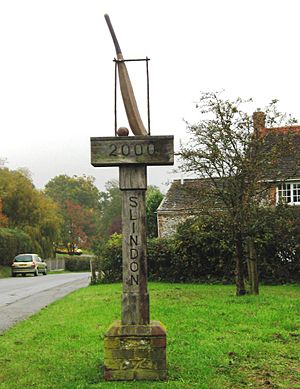1744 English cricket season facts for kids
Quick facts for kids 1744 English cricket season |
|
|---|---|
|
← 1743
1745 →
|
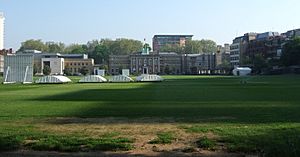
The 1744 cricket season in England is famous for the first time the Laws of Cricket were officially written down. These rules were created by members of several cricket clubs. Even though they were written in 1744, they weren't printed until 1755. Many cricket words we still use today, like no ball, over, toss, umpire, and wicket, come from these early laws.
This season is also special because we have the two oldest known scorecards from matches. One of these important matches was played on Monday, June 18th. A team from Kent played against an England team at the Artillery Ground. Kent won this exciting game by just one wicket.
Later in September, the Slindon Cricket Club beat the London Cricket Club. After their win, Slindon challenged "any parish in England" to a game. The Addington and Bromley clubs accepted the challenge. However, we don't have any records showing if these challenge matches were actually finished.
A simpler version of cricket called single wicket was very popular back then. We have reports of four big single wicket matches played at the Artillery Ground. There are also announcements or summaries for several matches with eleven players on each side. Some reports mention problems with crowds. To help control this, they started charging money to get in and limited how much alcohol was sold. People often bet a lot of money on cricket games, and some matches were played for very high stakes.
Contents
The First Cricket Rules
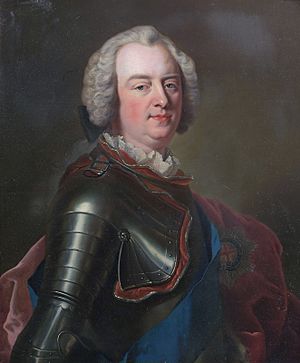
The first official Laws of Cricket were written down in 1744. Members from several clubs helped create them, including the London club, whose president was Frederick Louis, Prince of Wales. Club representatives met at a place called the Star and Garter tavern in Pall Mall, London. When the rules were printed in 1755, the title said: "The Game at Cricket, As settled by the Several Cricket-Clubs, Particularly that of the Star and Garter in Pall-Mall".
According to Wisden Cricketers' Almanack (a famous cricket book) in 1965, these Laws were probably an updated version of even older rules. But no older written rules have ever been found. However, we know that special agreements, called Articles of Agreement, were made for matches. For example, for games in 1727 between Charles Lennox, 2nd Duke of Richmond, and Alan Brodrick, 2nd Viscount Midleton.
Here are some of the main rules from the 1744 code:
- A coin toss decides which team bats first.
- The pitch (the middle playing area) must be 22 yards long.
- The bowling and popping crease lines must be drawn. The popping crease must be exactly 3 feet 10 inches in front of the bowling crease.
- The stumps (the wooden sticks) must be 22 inches high. They must have a six-inch (152 mm) bail (the small piece of wood on top).
- The ball must weigh between 5 and 6 ounces.
- Each over (a set of balls bowled) has four balls.
- A no ball is called if the bowler steps over the bowling crease with their back foot.
- Different ways a player can be "out" are listed. These include hitting the ball twice and obstructing the field (getting in the way of a fielder).
- The wicket-keeper (the player behind the stumps) must stay still and quiet until the ball is bowled.
- Umpires must allow two minutes for a new batsman to come to the field. They must also allow ten minutes between innings (turns at batting).
- The umpire cannot call a batsman out if the fielders (players trying to get the batsman out) do not ask for it.
- The umpire has some freedom to make decisions. It is clearly stated that the umpire is the "sole judge" and their decision is final.
There are four rules for bowlers. But they don't say the bowler must roll the ball along the ground. They also don't mention how the bowler's arm should move. It only says the bowler must "deliver the ball" with one foot behind the bowling crease. A cricket writer named Rowland Bowen said in 1965 that the ball was bowled along the ground in the early 1700s. This was the rule until the 1750s. But by the 1770s, bowlers started pitching the ball (bouncing it before it reached the batsman).
The First Scorecards
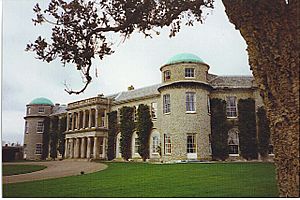
The 1744 season is also important because we have the two oldest surviving scorecards from matches. We don't find many more scorecards from big matches until the 1772 season. However, a few scorecards from smaller games have been found.
London vs. Surrey and Sussex Match
The first scorecard we have is from a match on June 2nd. It was played between the London Cricket Club and a combined team from Surrey and Sussex. The game took place at the Artillery Ground. This scorecard shows individual scores for players, but it doesn't say how they got out.
At that time, teams didn't have official names. Modern writers have given them names like London vs. Slindon. London was the home team, and their opponents were all from Surrey and Sussex. The 2nd Duke of Richmond kept this scorecard at Goodwood House.
|
2 June 1744
Scorecard |
|
Surrey and Sussex
|
v
|
London
|
- Toss not known
- Although the Laws of Cricket did not allow for declarations in 1744, it would seem that the combined XI declared their second innings closed with four wickets standing. The newspaper report says: "55 notches beat by and three men to go in".
The scorecard lists players by their last names only. It does show which players were brothers (the Harrises and Newlands). A newspaper called the Daily Advertiser listed the players expected to play. It also reported the same names after the match, but some of them don't appear on the scorecard.
Surrey and Sussex scored 102 runs in their first turn at batting (innings). They scored 102 runs for 6 wickets in their second innings. London scored 79 in their first innings and 70 in their second. So, Surrey and Sussex won the match by 55 runs. The highest score by one player in this game was 47 runs by John Harris from Surrey and Sussex. This was the first game where tickets were given out so spectators could leave and come back.
England vs. Kent Match: A Big Game
Just over two weeks later, on June 18th, another scorecard survived from a match at the Artillery Ground. This game was between an England team and the Kent county team. Lord John Sackville organized this match and was the captain for Kent.
England batted first and scored 40 runs in their first innings and 70 in their second. Kent scored 53 runs and then 58 runs for 9 wickets, winning the game by just one wicket. Richard Newland from England made the two highest individual scores in the match: 18 not out and 15. We don't have all the details of how players got out. But we know that Kent bowler William Hodsoll took at least eight wickets. This is the first scorecard we have that includes some details about dismissals. This match became the first entry in Arthur Haygarth's famous book Scores & Biographies, though he mistakenly listed the year as 1746 instead of 1744.
|
2 June 1744
Scorecard |
|
England
|
v
|
Kent
|
|
70
Richard Newland 15 William Hodsoll 4w |
- Toss not known
- While it is known that Hodsoll took eight wickets in the match, 21 wickets fell (7 each) to bowlers called Harris, Mills and Newland but there were two Harrises, two Millses and three Newlands playing and the card does not differentiate them.
The London Daily Advertiser newspaper called this match the "greatest cricket match ever known". It was a big social event, and many important people watched. This included the Prince of Wales and his brother, Prince William, Duke of Cumberland. Also there were the 2nd Duke of Richmond and Admiral Vernon. A poet named James Love (1722–1774) wrote a poem about it called Cricket: An Heroic Poem (1745). This poem is one of the first important pieces of writing about cricket. Former prime minister John Major said it is the earliest known cricket poem. James Love himself was a cricketer and played for the Richmond Cricket Club.
There were some problems with the crowd at this match. The Daily Advertiser reported on June 30th that it was "with difficulty the match was played out". Because of this, they decided to charge sixpence (a small amount of money) to get into future matches at the Artillery Ground. They also planned to put benches around the field for over 800 people. No one without special permission would be allowed inside this area.
Slindon's Challenges
On Monday, September 10th, the London club played against the Slindon Cricket Club at the Artillery Ground. The game continued into Tuesday. After winning, Slindon challenged "any parish in England" to a match. The Addington and Bromley clubs quickly accepted.
These matches were planned for the next few days at the Artillery Ground. We know that Slindon vs. Addington started on Wednesday, September 12th. Bad weather affected the game, and Slindon was ahead by two runs when play stopped. We don't have any reports of play on September 13th. Slindon's match against Bromley was set for Friday, September 14th, but there are no reports that it actually happened.
Single Wicket Matches
We have reports of four important matches played at the Artillery Ground using single wicket rules. This type of cricket was very popular in the 1740s. In these games, fewer players were on each side.
On Wednesday, June 13th, there was a one-on-one match between two unnamed players. They played "for a considerable sum of money" to decide who was the best player. On Monday, August 20th, another one-on-one match was played "for a large sum" between a player from Sevenoaks and a player from London.
On Monday, September 17th, a three-on-three match was advertised as "Long Robin's Side v R. Newland's Side". The players were described as the six best in England. One team had Robert Colchin ("Long Robin"), Val Romney, and John Bryant. The other team had Richard Newland, Edward Aburrow senior, and Joseph Harris. Aburrow played instead of John Mills, who was called the "famous Kent bowler". The prize for this game was two hundred guineas (a lot of money).
There was another three-on-three match on Monday, October 1st, again "for a considerable sum". In this game, Robert Colchin, James Bryant, and Joseph Harris played against John Bryant, Val Romney, and Thomas Waymark.
Other Eleven-a-Side Matches
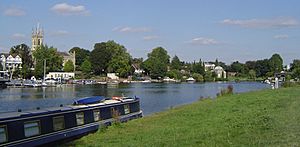
Reports exist of three earlier matches between teams called England and Kent. Two of these happened in May at places we don't know. Kent won both games. These matches later became part of a court case in 1748 about unpaid gambling debts. The famous match on June 18th was a return game for one played on Friday, June 15th, at Coxheath Common. We don't know the details or the result of that earlier match. The Kent team challenged "eleven pick'd from any part of England".
Also in May, an England team played against Surrey twice. The first game was at Moulsey Hurst on Monday, May 14th, and Surrey won by four runs. The return match on May 21st was at the Artillery Ground, but we don't have any details or the result. Before the second match, a newspaper warned spectators not to go onto the field or bring dogs into the ground.
During the season, there were three matches that modern records call "Two Elevens" because the teams were not named. The first of these was at the Artillery Ground on Thursday, July 5th. Spectators had to pay sixpence to get in. This is the earliest recorded admission charge for a cricket match. The second match started at Moulsey Hurst on Friday, July 6th, but it wasn't finished. One team was ahead by 31 runs with two wickets left to fall. Play continued at the Artillery Ground on the 7th. The admission price was lowered to the "usual" twopence. Near the end of the season, on Wednesday, September 19th, the Artillery Ground hosted "a great match between 22 of the best players from Kent, Surrey, Sussex and London".
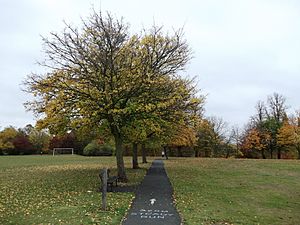
The important Addington and Bromley clubs, who accepted Slindon's challenge in September, were supposed to play each other on Friday, July 13th. We don't have any reports after the match. The game was planned for Bromley Common. An announcement before the match said that only people who lived in the parish could sell drinks there. The previous Monday, a combined Addington and Bromley team was scheduled to play a team called Surrey and the Rest of Kent at Duppas Hill in Croydon. A similar announcement before that match warned that no one could bring drinks into the ground unless they lived in the parish. Other announcements show that London was to host matches at the Artillery Ground against Addington on Monday, July 30th, and against Bromley on Monday, September 3rd. No reports after these matches have been found.
Reports or announcements have been found for five other eleven-a-side matches that involved London. On Monday, July 9th, London was supposed to play Richmond on Kennington Common, but no details about the match have survived. London planned a match against Woburn Cricket Club at the Artillery Ground for Thursday, July 19th. But it had to be moved back two days because the Honourable Artillery Company needed the ground. No report after this match has been found.
The other three London matches were against Surrey. They first played at Moulsey Hurst on Friday, August 24th, and London won. Robert Colchin from Bromley and Val Romney from Sevenoaks played for London as "given men" (players from other teams who joined for a specific match). The bets for this match were reported to be "£50 a side". There was a return match the next Monday, August 27th, at the Artillery Ground. London, with Colchin and Romney, won again. A third match was planned at the Artillery Ground for Friday, September 7th, with Romney playing for London, but we don't know any details after the match.


